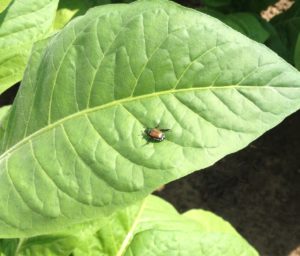Calls have come in regarding leaves wilting in the top of the plant. The question often is whether the wilting is being caused by stink bugs or something else. Figure 1 shows leaf wilting that is caused by feeding from stink bugs. Often feeding damage from a stink bug can be seen on the upper leaves or stalk of the plant. Another cause of leaf wilting in the top of the plant can be from high temperatures (i.e. in the 30s (°C)) and moisture stress, which have been common conditions this growing season. Figure 2 shows a leaf that has wilted at about the 4th to 5th larger leaf down from the bud. No signs of stink bugs or feeding were evident and, as a matter of fact, several plants in the field were showing the exact same symptom. This type of leaf wilting was caused from high temperatures and moisture stress. Leaves that become severely wilted in the top of the plant will often not recover properly and will remain small and be deformed. Figure 3 shows an area of a field that is near a cedar hedge. The damage from excessive heat and moisture stress is much more distinguishable and significant on several of the upper leaves since airflow in these types of areas is very minimal.

Figure 1. Tobacco plant showing symptoms of feeding from stink bugs. Leaves in growing point are wilted. Stink bug can be seen on the plant’s stalk just below the lowest wilted leaf. (Click on image to enlarge.)
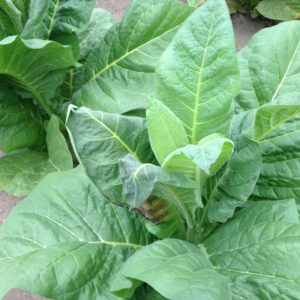
Figure 2. Leaf wilting in upper portion of plant caused by high temperatures and moisture stress. Because of the damage, some of these leaves may not recover properly and can remain small and be deformed. Photo taken July 15, 2016. (Click on image to enlarge.)

Figure 3. Upper leaves of plants damaged by excessive heat and moisture stress adjacent to a cedar windbreak where there is minimal airflow. Photo taken July 15, 2016. (Click on image to enlarge.)
Aphids and hornworms (see Figures 4 and 5) are being seen in fields now. Please refer to an earlier post in crop news on this website for information on thresholds and treating for these pests. Additional information about aphids and hornworms and their control can be found in technical bulletins posted in the Plant Protection area of this website and in OMAFRA publications 842 and 843.
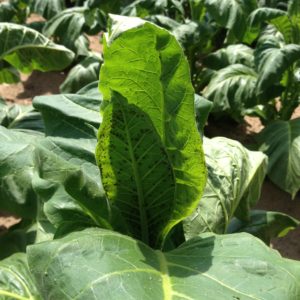
Figure 4. Red morph of green peach aphids on backside of leaf in bud of plant. Photo taken July 18, 2016. (Click on image to enlarge.)

Figure 5. Tomato hornworm feeding on a plant. Photo taken July 15, 2016. (Click on image to enlarge.)
Japanese beetles are also being seen in some fields. These beetles have shiny, coppery coloured wings and a metallic green head (see Figure 6). Feeding by Japanese beetles can result in holes in leaves, but the more distinguishable feeding by them is when only the veins of the leaves are left without any tissue between them or in other words the leaf becomes “skeletonized” (see Figure 7). There is no threshold established for Japanese beetles in tobacco here in Ontario, since damage is typically not significant enough to cause economic losses and warrant treatment.
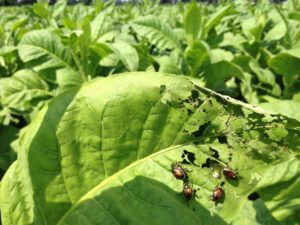
Figure 7. Feeding from Japanese beetles is starting to “skeletonize” the end of the tobacco leaf. (Click on image to enlarge.)
Late in June, we had our first report of tobacco infected with Potato Virus Y (PVY) (see Figure 8). It is not known as to how significant PVY will become this year. Spread of PVY is primarily by aphids. Control of aphids in tobacco may help to reduce spread of the disease from infected plants within a tobacco field. For more detailed information about PVY, please refer to the technical bulletin entitled “Tobacco Pests and Disorders in the Field – Potato Virus Y” posted in the Plant Protection area of this website.
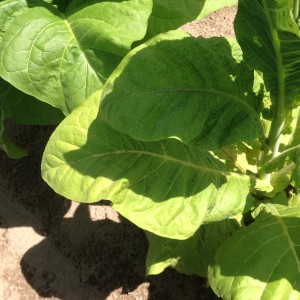
Figure 8. Tobacco plant showing symptoms of the necrotic strain of Potato Virus Y (PVY). (Click on image to enlarge.)
Post prepared and sent by Canadian Tobacco Research Foundation
Mailing Address: CTRF, P.O. Box 322, Tillsonburg, ON N4G 4H5
Telephone: 519-842-8997
Web Address: http://ctrf1.com


